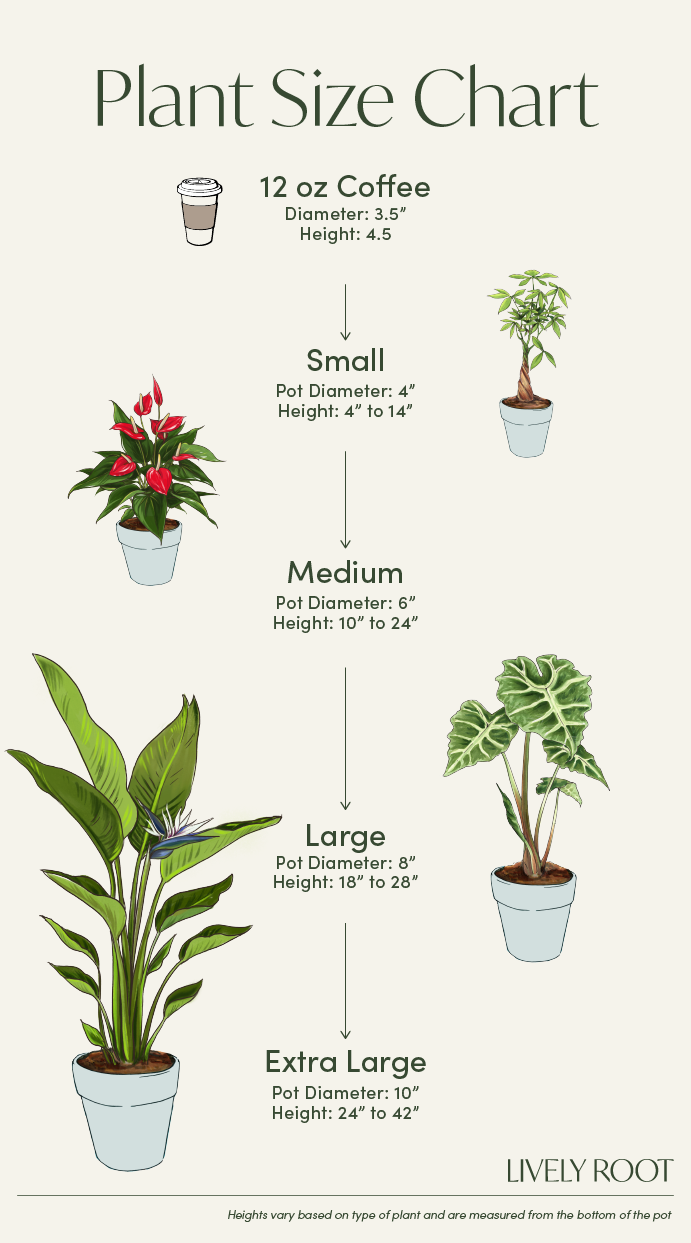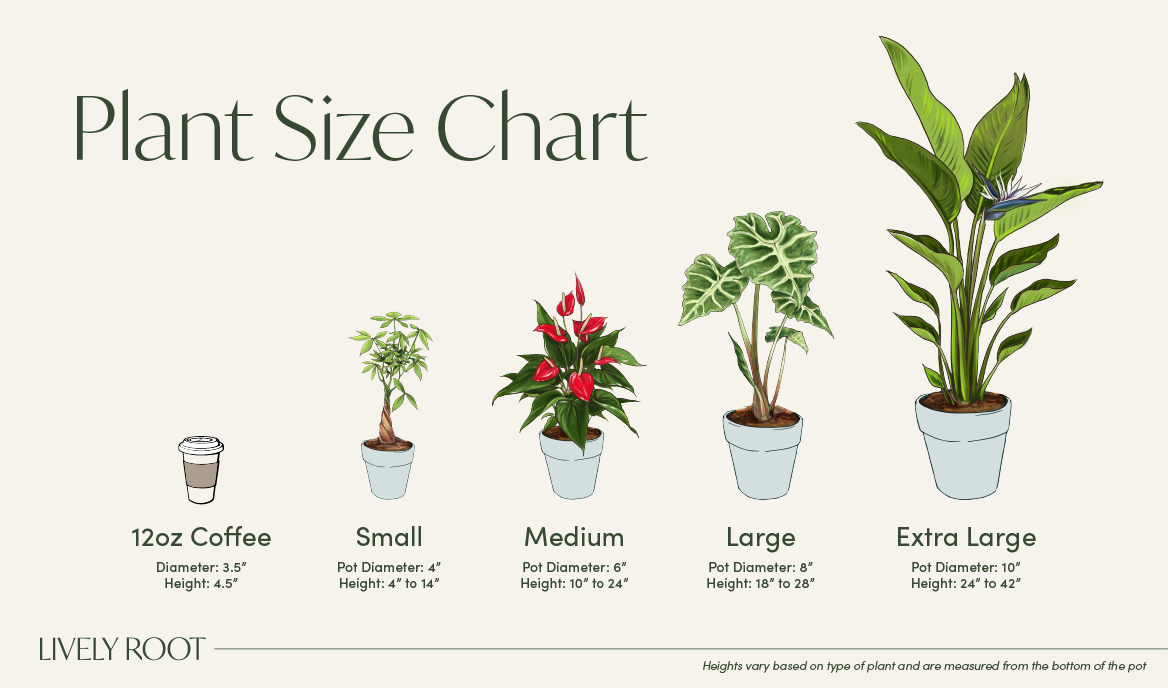

This plant will ship with a yellow or red bloom - growers' choice (we pick the healthiest, happiest plant!)
The flowers on the Hibiscus (Hibiscus rosa-sinensis) announce their debut with the trumpet-shaped flowers that embellish the green foliage of this shrub. In warm temperature zones, they can reach 10-12' tall when grown outdoors. Treat them as an annual in cooler sections of the country or bring them inside as a houseplant to overwinter. However, a few buds may drop with a change in lighting and temps, so do it gradually to help them adapt to their new environment. Their blooms are dynamic in color and can be a whopping 4-8" in diameter to wrap your space in a tropical vibe!
Hibiscus Care Guide & Presentation

Outdoors:This plant loves the sun and can be put on a patio outdoors in full sun to part shade where the temperatures don't dip below 50°F. Indoors: The Hibiscus shrub can be overwintered indoors in a brightly lit location. These plants may drop their buds in protest when positions are changed.
Use unsoftened, filtered, bottled, or tap water sitting 24 hours to release the chemicals and water enough that the water discharges out of the drainage holes. Once the water is fully drained, replace them into the cache or decorative pot. Replenish the soil moisture when it falls below 5 on the plant meter. Keep them consistently moist during the growing season (but not soggy) and let them dry out to a 3 on the moisture meter in winter months when they are dormant. If yellowing leaves occur, back off on the watering and let the soil dry out a bit more between waterings.
Hibiscus needs humidity at a rate of 40-60%. Use a pebble tray, humidifier and group plants together to raise the humidity levels.
This tropical plant loves warm climates and moderate humidity.
This plant will not tolerate frost or temperatures below 60°F if left outside.
Container: When the plant is rootbound or there is dieback on their growth, they are ready to repot (early spring before growth starts), plant in a 2" bigger container in diameter and slightly deeper than the existing planter. Use an indoor container mix that is well-draining. Add soil to the bottom to elevate the root ball. Lift the plant and inspect the root ball. Notice if there are any dead or rotting roots and trim them off with sterile pruners. If the plant is rootbound, cut through the roots to alleviate continued encircling. Ensure the plant is sitting about 1" below the edge of the pot to avoid water spillage. Add more soil and backfill around the sides by tamping down. Do not cover the current level of soil on the plant but add soil up to this level. Water thoroughly, leaving the soil damp but not soggy. Add more soil after watering if the soil settles. Outdoors: Before planting the Hibiscus into the ground, water the plant in the grower pot well. Find a spot in the garden where there are at least 6 hours of direct sunlight each day. Be generous by digging a hole twice the pot's width and 1 inch shorter than the grower pot to raise it above the soil level for good drainage. Use a pitchfork or a sharp object to stab the soil walls to make several indentions for the roots to take hold. Tickle the roots to loosen them if they wrap inside the container. Place the plant in the center of the hole. Fill the hole with water first, so the roots get another good drink. Next, backfill with native soil mixed with compost by one-third to one-half (if the native soil is clay). Add a rooting hormone fertilizer to this backfill mixture. Tamp the soil firmly down around the edges and mound up. Avoid covering the original soil level of the plant that was in the container. Add mulch as needed but not next to the stem or branches of the plant. Water lightly. Continue to observe the soil moisture each day, depending on the temperatures and soil drainage.
Prune in early spring and remove up to 1/3 of old wood to keep the plant blooming and dense with new growth.
Take green stem cuttings from the tips of the parent plant. Cut with sterile scissors taking a 3-6 inch cutting. Dip in rooting hormone and place them in moist potting soil. Cover with a clear plastic bag to retain moisture and humidity while they root. Keep the cuttings in bright, indirect light. After four weeks, check the rooting of the baby cutting by pulling gently on the leaf. If they are snug, then roots are forming. Keep them covered until new shoots appear. Remove the clear bag at this point and keep evenly moist and humidity levels high while they mature. Avoid moving locations during propagation.
Hibiscus Rosa-Sinensis: Overview
Hibiscus (Rosa sinensis) is a flowering shrub with vivid green, toothed leaves and trumpet-shaped flowers in different shades of pink, purple, red, white, or yellow. A Hibiscus flower can reach up to 8 inches in diameter but its exotic beauty is short-lived, as each flower blooms only for one day. With proper Hibiscus plant care, each shrub can produce around 20 flowers simultaneously, showcasing a stunning display. The flowers of Hibiscus (Hibiscus rosa-sinensis) also attract pollinators, like bees and butterflies to your garden. Hibiscus flowers are used to make a delicious, slightly sour tea. Studies show that Hibiscus tea benefits include anti-inflammatory properties, lowering blood pressure, and promoting weight loss.
Hibiscus can reach 10-12 ft. in size, living for around 20 years. This large plant is suitable for hardiness plant zones 9-12 but should be kept indoors during winter. The Hibiscus plant is very sun-loving and thrives in full sun to partial shade. Hibiscus requires some extra care, but while not the easiest plant to take care of, its gorgeous flowers, pet-friendliness, and other remarkable Hibiscus benefits make the additional effort worthwhile.
The yellow Hibiscus is the state flower of Hawaii and is associated with grace, hospitality, friendship, and beauty. The red Hibiscus plant symbolizes courage, love, and success in various Asian cultures.
Hibiscus Plant: Benefits
- Symbolizes love, friendship, and success
- Bright, large flowers with a pleasant, fruity scent
- It’s a non-toxic, pet-friendly plant
- The flowers have many medicinal properties when prepared as hibiscus tea
- Suitable for locations with full sun exposure
Rosa Sinensis: Alternative Names
- Chinese Hibiscus
- China Rose
- Hawaiian Hibiscus
- Shoeblack Plant
- Rose Mallow
Hibiscus Plant: Care Guide
Knowing how to care for a Hibiscus plant will help your Rose Mallow Hibiscus adapt quickly and start producing those amazing blossoms.
Light and Temperature
After you receive your Hibiscus, place it in a spot with a bright light. After it gets accustomed to the abundant sunshine, you can even move your plant into full sun.
Hibiscus is a tropical plant that thrives in warmer temperatures from 50℉ to 79℉. When temperatures drop below 50°F, bring your plant indoors and place it in a brightly lit location.
Watering and Humidity
Unlike succulents that can store water in their leaves, Hibiscus plants cannot, so they require consistent moist soil. Make sure your plant isn’t standing in water, which can lead to root rot, but provide regular watering so that the soil doesn’t get fully dry during the growing season. Water less in winter.
For the best Hibiscus rosa-sinensis care, provide additional humidity by misting the leaves, grouping the plant with other plants, or using a pebble tray.
Soil and Repotting
The best soil for Hibiscus plants is well-draining, nutrient-rich, and slightly acidic. Add perlite for enhanced drainage and increase acidity by adding peat moss. You can cover your plant’s soil with mulch to retain moisture.
Repot your plant when the roots start growing out of the drainage holes into a 2-inch larger pot.
Feeding and Propagation
Knowing how to care for Hibiscus plants involves fertilizing them correctly. Fertilize every two-three weeks during the growing season, letting the plant rest during winter.
You can propagate your China Rose via cuttings. Take several healthy cuttings in spring, pot them in moist soil (dipping in the cuttings root hormone is also optional), and then wait for the roots to form.
Pruning, Cleaning, and Common Issues
For the best Hibiscus care, prune during spring, removing one-third of the last year’s growth. This will increase the shrub’s density and produce more flowers.
The Hibiscus Rosa Sinensis can drop its buds if moved to a different location. If you notice yellow leaves on your Hibiscus, check the soil, as it could be a sign of overwatering. Curling, yellow-brown leaves indicate insufficient humidity or underwatering. If you suddenly move your Hibiscus into direct sun, it may develop whitish burns on its leaves. Also, check your plant for pests, like aphids or spider mites.
Rose Mallow Hibiscus: Placement, Companion & Alternative Plants
Flowering Hibiscus is a highly decorative and eye-catching plant that looks amazing whether you grow it in your garden or a pot.
Best Locations & Uses
- Great for patios with full sun
- Amazing gift plant that symbolizes love and courage
- Perfect for plant lovers with pets
- Ideal plant for experienced gardeners
- A wonderful bedroom or office plant because of its mood-lifting and air-filtering properties
Companion Plants
Combine your Hibiscus with other flowering plants to create a stunning porch garden:
- Peace Lily Plant (Spathiphyllum): The amazing white blooms of the Peace Lily give this graceful plant its elegant appearance, which along with its air-purifying properties make it a favorite houseplant.
- Giant Bird of Paradise (Strelitzia nicolai): The exotic Giant Bird of Paradise has huge, dramatic leaves and an unusual white-blue blossom that resembles a tropical bird.
- Blooming Kalanchoe Plant (Kalanchoe): The bright, long-lasting blooms of the Blooming Kalanchoe are sure to add a splash of color to your green oasis.
Alternative Plants
Other large plants to consider growing in your living space include:
- Fiddle Leaf Fig Tree (Ficus lyrata): With its pretty, violin-shaped leaves, the Fiddle Leaf Fig needs extra care to thrive, preferring medium light and a balanced watering schedule.
- Dieffenbachia Tropic Snow (Dieffenbachia seguine): The easy-care, air-filtering Dieffenbachia Tropic Snow is an amazing statement plant with colorful, green-and-cream leaves.
- Burgundy Rubber Tree (Ficus robusta 'Burgundy'): The Burgundy Rubber Tree boasts thick, glossy leaves, which are coral-red when they unfurl, gradually turning green as they get older.
Order Your Hibiscus Plant From Lively Root Today!
Get a stunning Hibiscus plant for sale in bright red or brilliant yellow from Lively Root today!




















